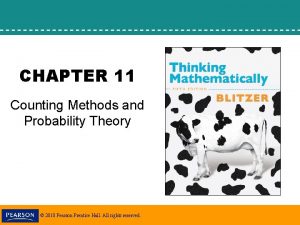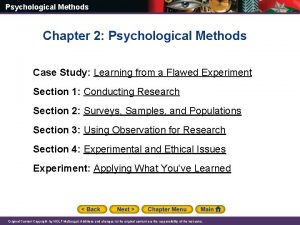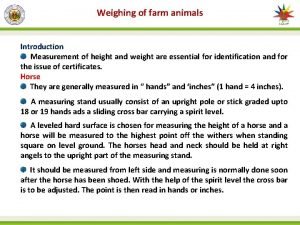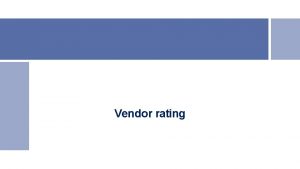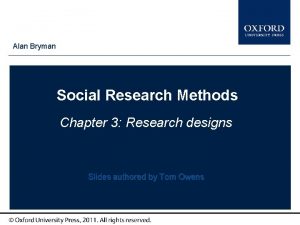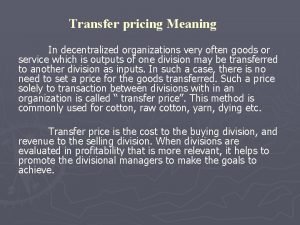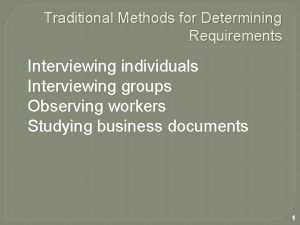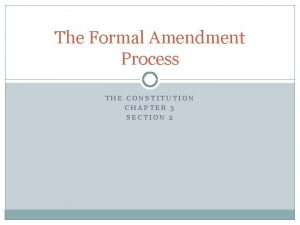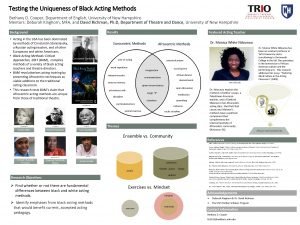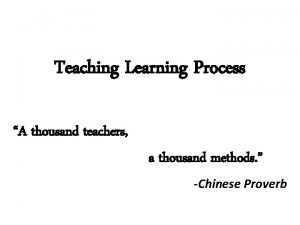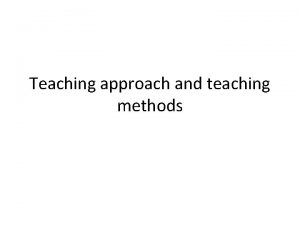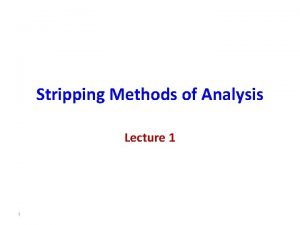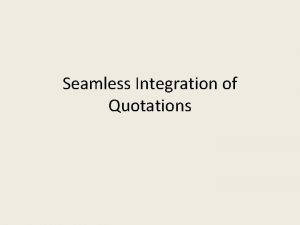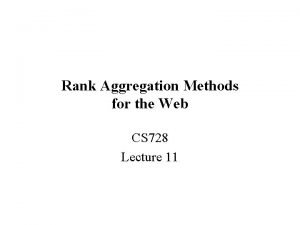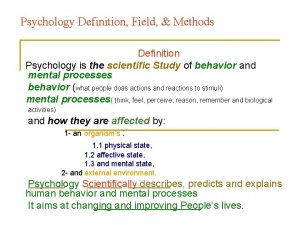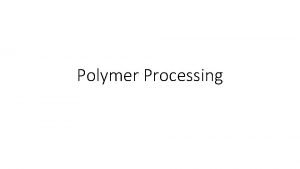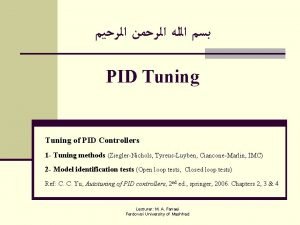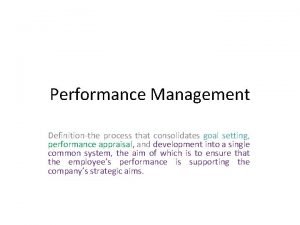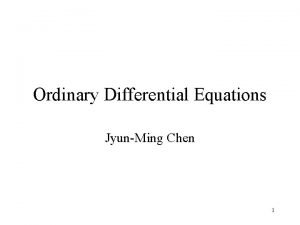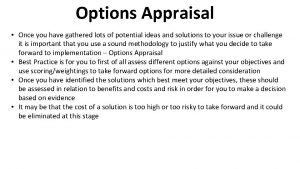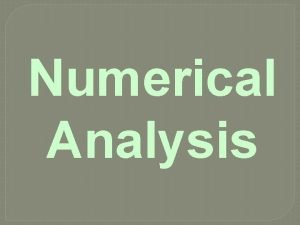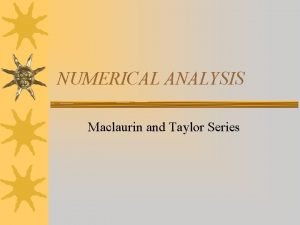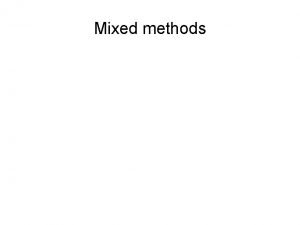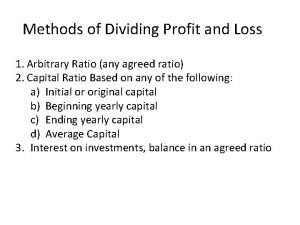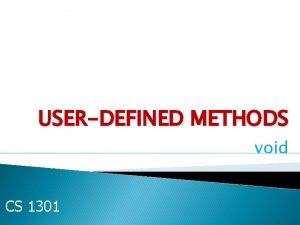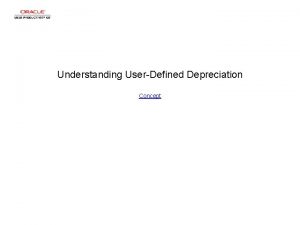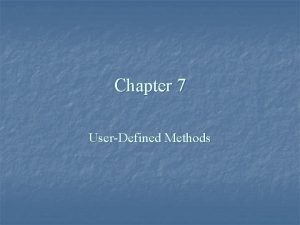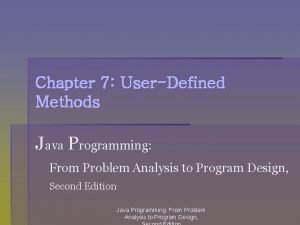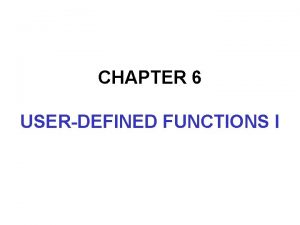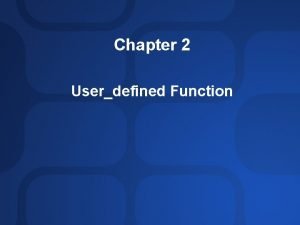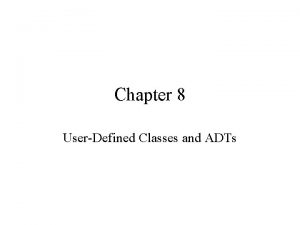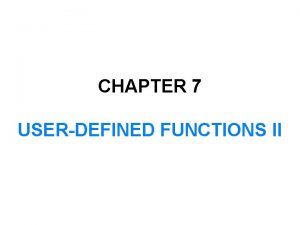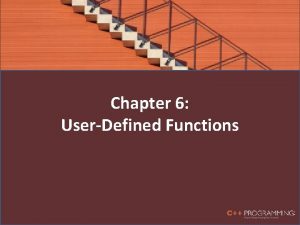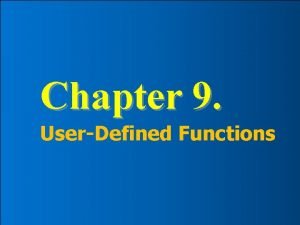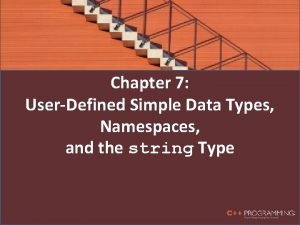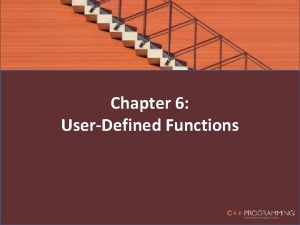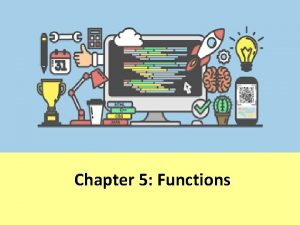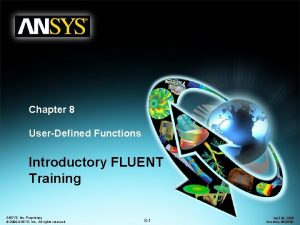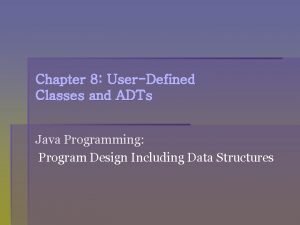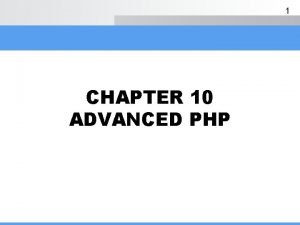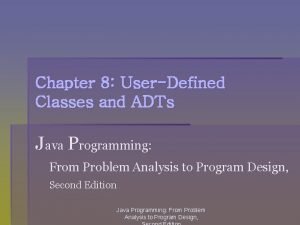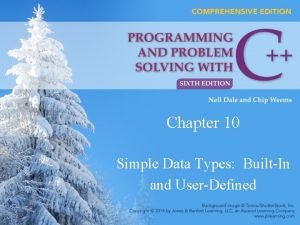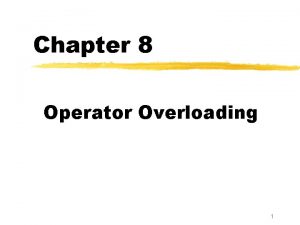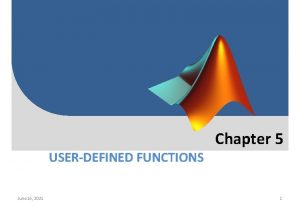Chapter 5 METHODS USERDEFINED METHODS userdefined 2 We
















































![49 Methods for Array Processing (search) public static int seq. Search(int[] list, int list. 49 Methods for Array Processing (search) public static int seq. Search(int[] list, int list.](https://slidetodoc.com/presentation_image_h/12fbcc626cecf3f6101c0af08161b202/image-49.jpg)
![Relational Operators and Arrays (example) 50 boolean are. Equal. Arrays(int[] first. Array, int[] second. Relational Operators and Arrays (example) 50 boolean are. Equal. Arrays(int[] first. Array, int[] second.](https://slidetodoc.com/presentation_image_h/12fbcc626cecf3f6101c0af08161b202/image-50.jpg)













































- Slides: 95

Chapter 5: METHODS USER-DEFINED METHODS

user-defined 2 We learned that a Java application program is a collection of classes, and that a class is a collection of methods and data members. use only the method main; all the programming instructions are packed into one method. For large programs, it is not practical to put the entire programming instructions into one method, You must learn to break the problem into manageable pieces. Java Programming: From Problem Analysis to Program Design, 4 e

Chapter Objectives 3 Learn about user-defined methods � Learn how to construct and user-defined void methods in a program � Actual and formal parameters � Explore how to construct and use a value-returning Explore using variables as parameters Explore using arrays as parameters. Java Programming: From Problem Analysis to Program Design, 4 e

Chapter Objectives (continued) 4 Learn about standard (predefined) methods and discover how to use them in a program Learn about the scope of an identifier Become aware of method overloading Java Programming: From Problem Analysis to Program Design, 4 e

Why use method 5 Using methods has several advantages: While working on one method, you can focus on just that part of the program and construct it, debug it, and perfect it. Different people can work on different methods simultaneously. If a method is needed in more than one place in a program, or in different programs, you can write it once and use it many times. Using methods greatly enhances the program’s readability because it reduces the complexity of the method main. Java Programming: From Problem Analysis to Program Design, 4 e

6 Syntax: Method Java Programming: From Problem Analysis to Program Design, 4 e

Syntax: Method 7 • There are 3 different criteria defining types of methods: • Modifiers: this criteria is also composed of 3 sub-criteria: » Visibility: public or private (or protected in csc 113) » Shared between all instances or not: class member (static) or instance method. » Override able or not (final): to be discussed in CSC 113. • Return type: method with or without (void) return value. • Parameters: with or without parameters. • Every method have two important elements : Method head: used to declare and define the method. Method call: used to invoke and employ this method.

User-Defined Methods 8 1 -Method Head : To declare a method, the user must specify the following: modifiers: public, private, protected, static, abstract, final return. Type: type of the value that the method calculates and returns (using return statement) method. Name: Java identifier; name of method formal parameter list: The syntax of the formal parameter list is: Java Programming: From Problem Analysis to Program Design, 4 e

User-Defined Methods 9 2 -Method call -The syntax to call a value-returning method is: - Actual parameter list are also called arguments The syntax of the actual parameter list (arguments) is: Java Programming: From Problem Analysis to Program Design, 4 e

User-Defined Methods 10 Void Methods: Defined by users. Call to method is always stand-alone statement Can use return statement to exit method early (optional) Java Programming: From Problem Analysis to Program Design, 4 e

Void Methods without Parameters: Syntax Method Definition The definition of void method without parameters has the following syntax: modifier(s) void method. Name( ) { statements } Method Call A method call has the following syntax: method. Name( ) ; To call a method, you use its name.

Void method: Example (1) Public static void the. Method( ) { System. out. println(“ 3”+”+”+” 4”+”=“+ (3+4)); }

Void method: Example (2) public static void draw. Rectangle ( ) { System. out. println(“Enter the dimensions of your rectangle ”); int x=read. next. Int(); int y=read. next. Int(); for( int i = 0 ; i < x ; i++ ) { for( int j = 0 ; j < y ; j++ ) System. out. print(“*”); System. out. println(); } }

Void Methods with Parameters: Syntax 14 Java Programming: From Problem Analysis to Program Design, 4 e

15 Void Methods with Parameters: Syntax (continued) To call a method you use its name, with the actual parameters (if any) in parentheses. Java Programming: From Problem Analysis to Program Design, 4 e

Formal parameters 16 Modifiers Method heading Method name Formal parameters public static void larger (double x, double y) { Formal parameters list if ( x >= y ) System. out. print(“The max is ”+x); else System. out. print(“the max is ”+ y); Method body } Java Programming: From Problem Analysis to Program Design, 4 e

Actual parameters Method call Actual parameters larger ( 2. 5 , 5. 4 ); Method call Actual parameters larger ( num 1 , num 2 ); Method call Actual parameters larger ( num 1 , 33, 2 ); 17 Java Programming: From Problem Analysis to Program Design, 4 e

Void method with parameters: Example public static void draw. Rectangle (int x, int y ) { for( int i = 0 ; i < x ; i++ ) { for( int j = 0 ; j < y ; j++ ) System. out. print(“*”); System. out. println(); } }

Void method with parameters: Example (print area of a rectangle) public static void areaof. Rectangle (int l, int w ) { System. out. println( “the Area of the rectangle is” + (l*w)); }

Flow of Execution 20 Execution always begins with the first statement in the method main User-defined methods execute only when called Call to method transfers control from caller to called method In method call statement, specify only actual parameters, not data type or method type Control goes back to caller when method exits Java Programming: From Problem Analysis to Program Design, 4 e

21 Execution begins Flow of Execution – Example with the 1 st (void) statement in main Public static void main( String args[]) { System. out. println(“Before call”); the. Method(); System. out. println(“Aftere call”); } Call to method transfers control from caller to called method Public static void the. Method( ) { System. out. println(“in method “); } Before call In method After call Control goes back to caller when method exits Java Programming: From Problem Analysis to Program Design, 4 e

22 Execution begins Flow of Execution – Example with the 1 st (parameters) statement in main Public static void main( String args[]) { System. out. println(“Before call”); method(“csc 111”); System. out. println(“Aftere call”); } Call to method transfers control from caller to called method and passing parameter from main to method Public static void method( String str) { System. out. println(str); } Before call csc 111 After call Control goes back to caller when method exits Java Programming: From Problem Analysis to Program Design, 4 e

Value returning Methods 23 Value-returning methods � Used in expressions � Calculate and return a value � Can save value for later calculation or print value Java Programming: From Problem Analysis to Program Design, 4 e

Value returning Methods: Syntax 24 Java Programming: From Problem Analysis to Program Design, 4 e

Value returning Methods: Syntax 25 Java Programming: From Problem Analysis to Program Design, 4 e

Value returning Methods: Actual and formal parameters Java Programming: From Problem Analysis to Program Design, 4 e 26

Value returning Methods: Actual and formal parameters Java Programming: From Problem Analysis to Program Design, 4 e 27

Return Statment 28 • Syntax: return statement • return statement will return the flow of the program from the method to the main method. • It is also used to return the value resulting from the method to the main method to be used their. -The return statement has the following syntax: return expr/value/variable; Important note: 1 -value returning methods must have a return statement 2 - The value they return must be the same as the method Java Programming: From Problem Analysis to Program Design, 4 e data type

29 Execution begins with the 1 st statement in main Flow of Execution – Example (no parameters) Public static void main( String args[]) { System. out. println(“Before call”); System. out. println( the. Method()); System. out. println(“Aftere call”); } Call to method transfers control from caller to called method Public static int the. Method( ) { int x= 1000; return x; } Before call 1000 After call Control goes back to caller when method exits Java Programming: From Problem Analysis to Program Design, 4 e

30 Execution begins with the 1 st statement in main Flow of Execution – Example (with parameters) Public static void main( String args[]) { System. out. println(“Before call”); System. out. println( method(6)); System. out. println(“Aftere call”); } Call to method transfers control from caller to called method Public static int method(int num ) { return ++num; } Before call 7 After call Control goes back to caller when method exits (return in this e. g) Java Programming: From Problem Analysis to Program Design, 4 e

31 Return Statement – Equivalent Examples public static double larger(double x, double y) { { if (x >= y) return x; else return y; double max; if (x >= y) max = x; else max = y; } return max; } Java Programming: From Problem Analysis to Program Design, 4 e if (x >= y) return x; return y; }

Examples (1) The int variable num contains the number that we want to compute the factorial public static int factorial (int num ) { int fact=1; for (int i=2; i<=num; i++) fact=fact*i; return fact; } Java Programming: From Problem Analysis to Program Design, 4 e 32

Examples (2): Palindrome Number 33 Palindrome: integer or string that reads the same forwards and backwards The method is. Palindrome takes a string as a parameter and returns true if the string is a palindrome, false otherwise Java Programming: From Problem Analysis to Program Design, 4 e

Examples (2) - Cont 34 public static boolean is. Palindrome(String str) { int len = str. length(); int i, j; j = len - 1; for (i = 0; i <= (len - 1) / 2; i++) { if (str. char. At(i) != str. char. At(j)) return false; j--; } return true; } Java Programming: From Problem Analysis to Program Design, 4 e

Example (3): Largest Number 35 Input: set of 10 numbers Output: largest of 10 numbers Solution � Get numbers one at a time � Method largest number: returns the larger of two numbers � For loop: calls method largest number on each number received and compares to current largest number Java Programming: From Problem Analysis to Program Design, 4 e

Examples (3) - Cont 36 static Scanner console = new Scanner(System. in); public static void main(String[] args) { double num; double max; int count; System. out. println("Enter 10 numbers. "); num = console. next. Double(); max = num; for (count = 1; count < 10; count++) { num = console. next. Double(); max = larger(max, num); } System. out. println("The largest number is " + max); } Java Programming: From Problem Analysis to Program Design, 4 e

Examples (3) - cont 37 Sample Run: Largest Number • Sample Run Enter 10 numbers: 10. 5 56. 34 73. 3 42 22 67 88. 55 26 62 11 The largest number is 88. 55 Java Programming: From Problem Analysis to Program Design, 4 e

38 Primitive VS. Reference Variables Week 12 Java Programming: From Problem Analysis to Program Design, 4 e

Primitive VS. Reference Variables • Primitive variables hold values of primitive data types. Example: int x = 5; x 1 x is primitive variable • Instance variables hold references of objects: the location (memory address) of objects in memory. Example: int [] arr = {1, 2, 3, 4, 5}; arr is reference variable, it carries the address of the location of the array 1100 arr 1100 39 1 2 3 4 5

40 Primitive Data Type Variables as Parameters A formal parameter receives a copy of its corresponding actual parameter If a formal parameter is a variable of a primitive data type: � Value of actual parameter is directly stored � Cannot pass information outside the method � Provides only a one-way link between actual parameters and formal parameters Java Programming: From Problem Analysis to Program Design, 4 e

Reference Variables as Parameters 41 If a formal parameter is a reference variable: � Copies value of corresponding actual parameter � Value of actual parameter is address of the object where actual data is stored � Both formal and actual parameter refer to same object Java Programming: From Problem Analysis to Program Design, 4 e

42 Uses of Reference Variables as Parameters Can return more than one value from a method Can change the value of the actual object When passing address, would save memory space and time, relative to copying large amount of data Java Programming: From Problem Analysis to Program Design, 4 e

43 Declaring Arrays as Formal Parameters to Methods A general syntax to declare an array as a formal parameter public static void arrays. As. Formal. Parameter(int[] list. A, double[] list. B, int num) { //. . . } int[] int. List = new int[10]; double[] double. Num. List = new double[15]; int number; arrays. As. Formal. Parameter(int. List, double. Num. List, number); Java Programming: From Problem Analysis to Program Design, 4 e

Arrays as Parameter to Methods 44 Java Programming: From Problem Analysis to Program Design, 4 e

Methods for Array Processing 45 Java Programming: From Problem Analysis to Program Design, 4 e

Methods for Array Processing (continued) 46

Methods for Array Processing (continued) 47 Java Programming: From Problem Analysis to Program Design, 4 e

48 Methods for Array Processing (elements of array as par. ) Java Programming: From Problem Analysis to Program Design, 4 e
![49 Methods for Array Processing search public static int seq Searchint list int list 49 Methods for Array Processing (search) public static int seq. Search(int[] list, int list.](https://slidetodoc.com/presentation_image_h/12fbcc626cecf3f6101c0af08161b202/image-49.jpg)
49 Methods for Array Processing (search) public static int seq. Search(int[] list, int list. Length, int search. Item) { int loc; boolean found = false; loc = 0; while (loc < list. Length && !found) if (list[loc] == search. Item) found = true; else loc++; if (found) return loc; else return -1; } Java Programming: From Problem Analysis to Program Design, 4 e 49
![Relational Operators and Arrays example 50 boolean are Equal Arraysint first Array int second Relational Operators and Arrays (example) 50 boolean are. Equal. Arrays(int[] first. Array, int[] second.](https://slidetodoc.com/presentation_image_h/12fbcc626cecf3f6101c0af08161b202/image-50.jpg)
Relational Operators and Arrays (example) 50 boolean are. Equal. Arrays(int[] first. Array, int[] second. Array) { if (first. Array. length != second. Array. length) return false; for (int index = 0; index < first. Array. length; index++) if (first. Array[index] != second. Array[index]) return false; return true; } if (are. Equal. Arrays(list. A, list. B)). . . Java Programming: From Problem Analysis to Program Design, 4 e

Arrays and Variable Length Parameter List 51 The syntax to declare a variable length formal parameter (list) is: data. Type. . . identifier Java Programming: From Problem Analysis to Program Design, 4 e

Arrays and Variable Length Parameter List (continued) 52 Java Programming: From Problem Analysis to Program Design, 4 e

53 Arrays and Variable Length Parameter List (continued) Java Programming: From Problem Analysis to Program Design, 4 e

Arrays and Variable Length Parameter List (continued) 54 • A method can have both a variable length formal parameter and other formal parameters; consider the following method heading: public static void my. Method(String name, double num, int. . . int. List) • The formal parameter name is of type String, the formal parameter num is of type double, and the formal parameter int. List is of variable length • The actual parameter corresponding to int. List can be an int array or any number of int variables and/or int values Java Programming: From Problem Analysis to Program Design, 4 e

55 Arrays and Variable Length Parameter List (continued) A method can have at most one variable length formal parameter If a method has both a variable length formal parameter and other types of formal parameters, then the variable length formal parameter must be the last formal parameter of the formal parameter list Java Programming: From Problem Analysis to Program Design, 4 e

Reference Variables as Parameters: type String (special case) Java Programming: From Problem Analysis to Program Design, 4 e 56

Reference Variables as Parameters: type String (continued) Java Programming: From Problem Analysis to Program Design, 4 e 57

Reference Variables as Parameters: type String (continued) Java Programming: From Problem Analysis to Program Design, 4 e 58

Reference Variables as Parameters: type String (continued) Java Programming: From Problem Analysis to Program Design, 4 e 59

Reference Variables as Parameters: type String (continued) String str = "Hello"; Java Programming: From Problem Analysis to Program Design, 4 e //Line 5 60

Reference Variables as Parameters: type String (continued) string. Parameter(str); Java Programming: From Problem Analysis to Program Design, 4 e //Line 7 61

Reference Variables as Parameters: type String (continued) p. Str = "Sunny Day"; //Line 14 Java Programming: From Problem Analysis to Program Design, 4 e 62

Reference Variables as Parameters: type String (continued) Variables before the statement in Line 8 executes Java Programming: From Problem Analysis to Program Design, 4 e 63

Predefined Classes 64 Methods already written and provided by Java Organized as a collection of classes (class libraries) To use: import package Method type: data type of value returned by method Java Programming: From Problem Analysis to Program Design, 4 e

Predefined Classes (continued) 65 Java Programming: From Problem Analysis to Program Design, 4 e

Predefined Classes (continued) 66 Java Programming: From Problem Analysis to Program Design, 4 e

67 Java Programming: From Problem Analysis to Program Design, 4 e

68 Predefined Classes (continued) Java Programming: From Problem Analysis to Program Design, 4 e

69 random() return a value of type double greater than or equal to 0. 0 and less than 1. 0. Java Programming: From Problem Analysis to Program Design, 4 e

Example 70 double x = Math. pow(3, 2); double area = Math. PI*radius; If you use the static import statement, you can omit the name of class import static java. lang. Math. *; double x = pow(3, 2); - Java Programming: From Problem Analysis to Program Design, 4 e

71 Generating random variable in range General form random. Num = (int) (Math. random()*maximum)+minimum ; Rollin dice int dice 2 = (int) (Math. random() * 6) + 1; Java Programming: From Problem Analysis to Program Design, 4 e

class Character (Package: java. lang) 72 Java Programming: From Problem Analysis to Program Design, 4 e

73 class Character (Package: java. lang) (continued) Java Programming: From Problem Analysis to Program Design, 4 e

74 class Character (Package: java. lang) (continued) Java Programming: From Problem Analysis to Program Design, 4 e

75 Scope and overloading Week 13 Java Programming: From Problem Analysis to Program Design, 4 e

Scope of an Identifier within a Class 76 Local identifier: identifier declared within a method or block, which is visible only within that method or block Java does not allow the nesting of methods; you cannot include the definition of one method in the body of another method Within a method or a block, an identifier must be declared before it can be used; a block is a set of statements enclosed within braces Java Programming: From Problem Analysis to Program Design, 4 e

77 Scope of an Identifier within a Class (continued) A method’s definition can contain several blocks � The body of a loop or an if statement also form a block Within a class, outside of every method definition (and every block), an identifier can be declared anywhere Java Programming: From Problem Analysis to Program Design, 4 e

78 Scope of an Identifier within a Class (continued) Within a method, an identifier used to name a variable in the outer block of the method cannot be used to name any other variable in an inner block of the method For example, in the method definition on the next slide, the second declaration of the variable x is illegal Java Programming: From Problem Analysis to Program Design, 4 e

Scope of an Identifier within a Class (continued) 79 public static void illegal. Identifier. Declaration() { int x; //block { double x; //illegal declaration, //x is already declared . . . } } Java Programming: From Problem Analysis to Program Design, 4 e

Scope Rules 80 Scope rules of an identifier declared within a class and accessed within a method (block) of the class An identifier, say X, declared within a method (block) is accessible: � Only within the block from the point at which it is declared until the end of the block � By those blocks that are nested within that block Java Programming: From Problem Analysis to Program Design, 4 e

Scope Rules (continued) Example 7 -11 81 public static int w; public static void two(int one, int z) { char ch; int a; } } //block three { int x = 12; //. . . } //end block three //. . . Java Programming: From Problem Analysis to Program Design, 4 e

Scope Rules (continued) 82 Suppose X is an identifier declared within a class and outside of every method’s definition (block) � If X is declared without the reserved word static (such as a named constant or a method name), then it cannot be accessed in a static method � If X is declared with the reserved word static (such as a named constant or a method name), then it can be accessed within a method (block), provided the method (block) does not have any other identifier named X Java Programming: From Problem Analysis to Program Design, 4 e

Scope Rules (continued) Example 7 -11 83 { public class Scope. Rules static final double rate = 10. 50; static int z; static double t; public static void main(String[] args) { int num; double x, z; char ch; //. . . } public static void one(int x, char y) { //. . . } Java Programming: From Problem Analysis to Program Design, 4 e

Scope Rules (continued) Example 7 -11 84 public class Scope. Rules { static final double rate = 10. 50; static int z; static double t; public static void main(String[] args) { int num; double x, z; char ch; //. . . } public static void one(int x, char y) { //. . . } public static int w; public static void two(int one, int z) { char ch; int a; static final double rate static int z; static double t; main int num; double x, z; char ch; Method one(int x, char y) public static int w; Method two(int one, int z) { int x = 12; } //. . . } } Java Programming: From Problem Analysis to Program Design, 4 e char ch; int a; int x = 12;

Scope Rules: Demonstrated (continued) 85 Java Programming: From Problem Analysis to Program Design, 4 e

Scope Rules: Demonstrated 86 Java Programming: From Problem Analysis to Program Design, 4 e

Scope Rules – Scanner Example 87 public class Scope. Rules { Can be accessed static Scanner read=new Scanner (System. in); from any method public static void main(String[] args){ (static & nonint number = read. next. Int(); static) including //… } main, } public class Scope. Rules { public static void main(String[] args){ Scanner read=new Scanner (System. in); int number = read. next. Int(); ‘Local ‘ accessed //… } from main only } public class Scope. Rules { Scanner read=new Scanner (System. in); public static void main(String[] args){ Can be accessed int number = read. next. Int(); from non-static //… } method only Java Programming: From Problem Analysis to Program Design, 4 e }

Method Overloading: An Introduction 88 Method overloading: more than one method can have the same name Two methods are said to have different formal parameter lists if both methods have: � A different number of formal parameters, or � If the number of formal parameters is the same, then the data type of the formal parameters, in the order you list, must differ in at least one position Java Programming: From Problem Analysis to Program Design, 4 e

Method Overloading 89 public void method. One(int x) void method. Two(int x, double y) void method. Three(double y, int x) int method. Four(char ch, int x, double y) public int method. Five(char ch, int x, String name) These methods all have different formal parameter lists Java Programming: From Problem Analysis to Program Design, 4 e

Method Overloading (continued) 90 public void method. Six(int x, double y, char ch) public void method. Seven(int one, double u, char first. Ch) The methods method. Six and method. Seven both have three formal parameters and the data type of the corresponding parameters is the same These methods all have the same formal parameter lists Java Programming: From Problem Analysis to Program Design, 4 e

Method Overloading (continued) 91 Method overloading: creating several methods, within a class, with the same name The signature of a method consists of the method name and its formal parameter list Two methods have different signatures if they have either different names or different formal parameter lists � Note that the signature of a method does not include the return type of the method Java Programming: From Problem Analysis to Program Design, 4 e

Method Overloading (continued) 92 The following method headings correctly overload the method. XYZ: public void method. XYZ() method. XYZ(int x, double y) method. XYZ(double one, int y) method. XYZ(int x, double y, char ch) Java Programming: From Problem Analysis to Program Design, 4 e

Method Overloading (continued) 93 public void method. ABC(int x, double y) public int method. ABC(int x, double y) Both these method headings have the same name and same formal parameter list These method headings to overload the method. ABC are incorrect In this case, the compiler will generate a syntax error � Notice that the return types of these method headings are different Java Programming: From Problem Analysis to Program Design, 4 e

Chapter Summary 94 Predefined methods User-defined methods � Value-returning methods � Void methods � Formal parameters � Actual parameters Flow of Execution Java Programming: From Problem Analysis to Program Design, 4 e

Chapter Summary (continued) 95 Primitive data type variables as parameters � One-way link between actual parameters and formal parameters (limitations caused) Reference variables as parameters � Can pass one or more variables from a method � Can change value of actual parameter Scope of an identifier within a class Method overloading Java Programming: From Problem Analysis to Program Design, 4 e
 Metal coping fpd
Metal coping fpd Chapter 19 methods of therapy
Chapter 19 methods of therapy Chapter 11 counting methods and probability theory answers
Chapter 11 counting methods and probability theory answers Single blind study
Single blind study Scientific method bellringer
Scientific method bellringer Psychology chapter 2 section 1
Psychology chapter 2 section 1 Research methods for business students chapter 5
Research methods for business students chapter 5 Persuasive essay quotes
Persuasive essay quotes Traditional wood joints
Traditional wood joints Destructive and nondestructive testing of welds
Destructive and nondestructive testing of welds Methods of weighing animals
Methods of weighing animals Warehouse area calculation
Warehouse area calculation Vertical measurement
Vertical measurement Supplier rating system
Supplier rating system U vegetable
U vegetable Blood glucose estimation methods
Blood glucose estimation methods Sliding scale valuation method
Sliding scale valuation method Innovative teaching methods in english
Innovative teaching methods in english Using risk to balance agile and plan driven methods
Using risk to balance agile and plan driven methods Procurement plan
Procurement plan Alan bryman social research methods
Alan bryman social research methods What is translation loss
What is translation loss Transfer pricing methods with examples
Transfer pricing methods with examples Traditional method of fish preservation
Traditional method of fish preservation Traditional methods for determining system requirements
Traditional methods for determining system requirements What is thrust augmentation
What is thrust augmentation Typically involves high heat with 300°f or hotter
Typically involves high heat with 300°f or hotter 3 acceptable methods of thawing food
3 acceptable methods of thawing food Amendment process
Amendment process Ck metrics
Ck metrics A method of characterization is
A method of characterization is Black acting methods
Black acting methods Tdd testing private methods
Tdd testing private methods Teaching learning material
Teaching learning material A thousand teachers a thousand methods means
A thousand teachers a thousand methods means Characteristics of good teaching methods
Characteristics of good teaching methods Types of fact gathering in system analysis and design
Types of fact gathering in system analysis and design Energy method in structural analysis
Energy method in structural analysis Stripping methods
Stripping methods Stock valuation grade 12
Stock valuation grade 12 Sterilization by mechanical methods
Sterilization by mechanical methods Principle of autoclave ppt
Principle of autoclave ppt Convergent design mixed methods
Convergent design mixed methods Koster stain
Koster stain Oil spill
Oil spill The mode of motion in size separation method is
The mode of motion in size separation method is 6 shading techniques
6 shading techniques Integrated quotation
Integrated quotation Quota sampling definition
Quota sampling definition Salting fish
Salting fish Types of sampling psychology
Types of sampling psychology Research methods notes
Research methods notes Methods of social psychology
Methods of social psychology Research methods in developmental psychology
Research methods in developmental psychology Classification of research methods
Classification of research methods Research design methods
Research design methods Define recuritment
Define recuritment Dda line drawing algorithm
Dda line drawing algorithm Rank aggregation methods for the web
Rank aggregation methods for the web Public relations research methods
Public relations research methods Psychology definition
Psychology definition Non constructive proof
Non constructive proof Hydrogen production methods ppt
Hydrogen production methods ppt Advantages and disadvantages of primary research
Advantages and disadvantages of primary research Menu pricing methods
Menu pricing methods Define sterilization slideshare
Define sterilization slideshare Modified bishop score
Modified bishop score Positioning marketing
Positioning marketing Classification of extrusion process
Classification of extrusion process Pid controller tuning methods
Pid controller tuning methods Phytochemical screening methods
Phytochemical screening methods Permanent joint
Permanent joint Management by objectives performance appraisal
Management by objectives performance appraisal Absolute performance standard
Absolute performance standard Methods of performance appraisal
Methods of performance appraisal Electronic cooling methods
Electronic cooling methods Graphical and numerical methods
Graphical and numerical methods Explicit euler method matlab
Explicit euler method matlab Options appraisal template
Options appraisal template What is fullness in garment
What is fullness in garment Shooting method using euler's method
Shooting method using euler's method Golden methods
Golden methods Definition of numerical methods
Definition of numerical methods Taylor series numerical methods
Taylor series numerical methods Aztec yucatan peninsula
Aztec yucatan peninsula Communication delivery methods
Communication delivery methods Tonal montage example
Tonal montage example Alternative method of procurement
Alternative method of procurement Examples of mixed methods research
Examples of mixed methods research Mixed methods research examples
Mixed methods research examples Pragmatisk tilgang
Pragmatisk tilgang Mixed methods program evaluation
Mixed methods program evaluation Surface mining methods
Surface mining methods How to reduce water pollution
How to reduce water pollution Method of repertorization
Method of repertorization Arbitrary ratio meaning
Arbitrary ratio meaning


